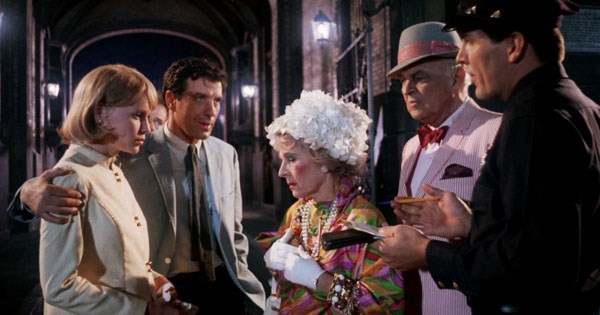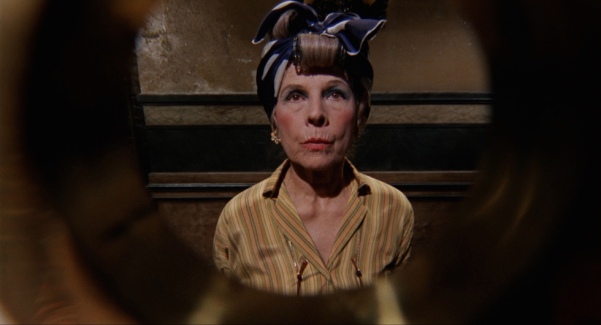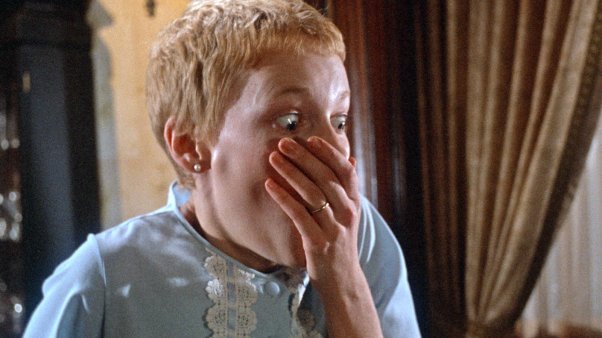Where every anniversary is a scream!
Rosemary’s Baby, Polish director Roman Polanski’s fifth feature film if you don’t count his contribution to the anthology, The World’s Most Beautiful Swindlers, is for all intents and purposes a supernatural horror film. It dabbles in the occult, features multiple shots of monstrous hands, and its most notable shot is an extreme close-up of Satanic yellow eyes. Rosemary (Mia Farrow) herself becomes impregnated with the devil’s child, which is part of the climactic reveal, though it’s hinted at with talks of witchcraft and her craving for uncooked red meat. If Rosemary’s Baby was made for the 21st century audience, and not remade into a four-hour television mini-series, its main draw and focus would be the terrifying reveal of its supernatural element.
Films like House of the Devil – which is a wonderfully gripping trip through hell – are more concerned with what sinister presence lies in the darkness rather than what the darkness represents and who it envelops. Like its concerned house sitter, Jocelin (Samantha Hughes), Ti West’s second feature film builds and bends tension through a curiosity of who or what is upstairs – and yes, it’s a nagging curiosity to say the least – never quite embracing the fear within its central character until the entire house is coming down around us (figuratively, of course). Much of the dramatic draw and frightful realization in Rosemary’s Baby comes through its focus on its titular mother-to-be, as the neighborly greeting of nearby tenants descends on us with an unnatural heaviness.

There’s a soapy melodrama to the first act that highlights Mia Farrow’s Manhattanite, who finds a fashionable corner – the Dakota, a peaked cooperative in the Upper West Side – with her husband, Guy Woodhouse (John Cassavetes). He’s a mildly unsuccessful actor, though Rosemary eagerly proclaims it with equally mild triumph, telling anyone who asks that he’s starred in “Luther and Nobody Loves an Albatross and a lot of television plays and commercials!” It’s stated with less pride and more urgency, perhaps to enunciate their class status, or even raise Guy’s spirits, which remain dour in a way only Cassavetes can direct within himself (it should be noted that Polanski and Cassavetes never saw eye to eye on choice directing).
Tension is harnessed through the films seemingly innocuous flirtations with socialite drama, steering audience expectations with a deceitful rouse. It’s the devil’s game, where nothing is really as it seems. Rosemary’s well-heeled bohemian-esque neighbors, Minnie (Ruth Gordon, who snagged an Academy Award for Best Supporting) and Roman Castevet (Sidney Blackmer), inundate the Woodhouse’s with Mrs. Rogers level conviviality, which begins to border on pestering. Rosemary feels so overwhelmed with Minnie’s sweetly suffocating approach that she at one point hosts her own dinner party, where the age limit is 60.
Ruth Gordon fits into the cutout of Minnie as if she may have been her in another life, and with the supernatural uncertainty of her character, perhaps she was. She chews her food with a cud-like tenacity, snipping her A’s in a chummy New York way whenever she gets a moment. Everyone has met this woman, or at the very least a variation, and Ruth Gordon sells it like the devil demands it. Which is all part of the films complete conviction to its genre; knowing exactly how to peddle an illusion – in this case, horror realism with cloven hooves masquerading as an apartment sensationalist drama.

We buy it the same way we buy Ruth as Minnie, and Minnie as a blush-coated neighbor who has a sinister agenda. The layers within Ira Levin’s novel, which Polanski wrote the screenplay off of, leap from the pages in a way that’s informing us that what we’re seeing is inevitable; despite everything feeling like it’s in our control. Rosemary hardly leaves the confines of her new abode, fixing shelf liners for a closet that was once mysteriously barricaded or playing housewife with trips to the laundry room located in the basement. By extension we too never leave the apartment, becoming Rosemary and in turn, feeling like we have an otherworldly control over her actions and the consequences that come with them.
Except that’s hardly how film works, and it’s nowhere near the way Polanski works. He enjoys leading us through the darkness of his characters subconscious, connecting us to the recesses of ones fears and anxieties. There’s a very real tangibility between Rosemary’s world and the hazy dreams she’s tethered to – isolation and loneliness take the form of open water, similar to the receding tide of Cul-De-Sac – deliberately (and masterfully) embracing the characters over the plot. Little details are meticulously placed so we quickly understand what’s unfolding, whether it’s our slight suspicion over Guy’s visits with the Casevete’s or his luck at replacing an actor for a lead in a big part after they inexplicably go blind.
In one of the films pivotal scenes, Rosemary fades in and out of consciousness as Guy – besieged by a coven of elderly socialites – proceeds to rape her. It’s delirious, haunting, and empirical of the films direction. We see such a horrendous and unthinkable act transpire between someone she trusts, committed within the fog of a vague nightmare. We know it’s real – Rosemary famously shrieks, “This is no dream! This is really happening!” – yet the finely tuned world Polanski has made continues to poke at us, asking if this unimaginable act is actually the nightmare it feels like.

Mia Farrow, who came into the film a rather unknown after starring in televisions Peyton Place, embodies Rosemary with the traditionalism of womanhood and the free love of the 1960’s. She glides around her Dakota home with a veneer of fragility that coats a strong willed woman, one who carries gaunt eyes and concave cheeks that hides a mother-to-be. She believes her child isn’t well – sharp pain antagonizes her for months during her pregnancy – visiting a doctor who happens to be a friend of the Casevete’s. Her own ability and agency is divided between walls where the devil plays; purported witches who keep an eye on the well-being of the films curiosity.
Except the curiosity growing inside Rosemary isn’t the reveal. We know what is happening well before the 3rd act, and it’s what makes the film work above cinemas countless satanic malevolence; its insistence to continue the melodrama of its environment, even with impending darkness moving in. Polanski makes it not about the story, or even Satan, but the characters, which prove that the horror of the reveal lies in seeing how far we’ve come with Rosemary. Because the thing we’ve been waiting to catch a glimpse of hasn’t remained hidden, but out in the open, moving freely amongst Rosemary, demonstrating that in the end, the scariest thing you can possibly reveal is just how sinister your neighbors are.
